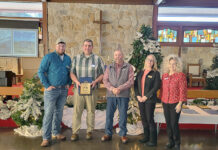Start a tractor by firing a shotgun shell? You’ve got to be kidding! However, the post-World War II Field Marshall tractor used just such a method of starting.
Marshall, Sons & Co., Ltd., ran the Brittania Iron Works at Gainsborough, Lincolnshire, in northeastern England. The firm was founded in 1848 and soon began building threshing machines and, in 1856, portable steam engines.
Marshall’s made many of the heavy steam-powered, cable plowing engines that were so popular in Great Britain during the late 1800s and first half of the 20th century, along with many threshing “drums” as threshing machines are known over there.
Beginning about 1930, Marshall’s began making a compression-ignition tractor with a one cylinder diesel engine. The Marshall 18-30 tractor cost 310 pounds against the British built Fordson that sold for only 155 pounds in 1934.
Marshall engineers developed a 12-20 model to compete with the Fordson, but the world-wide depression of the 1930s intervened and Marshall’s went into receivership in 1935.
Survived Depression
A Sheffield firm, Thomas W. Ward & Co., bought into Marshall’s and the infusion of cash allowed the light tractor project to continue, only to be interrupted in September, 1939, by the onset of World War II.
During the war, Marshall’s made lots of military hardware, as well as continuing production of tractors and threshers to aid British farmers in stepping up food production to counter the German Uboat blockade. Marshall engineers also began work on a new tractor, to be called the Field Marshall, that would replace their aging models.
Chunky machine
Introduced to the public in June, 1945, the chunky, powerful-looking machine weighed 6,500 pounds and was painted Brunswick green with silver wheels.
On the left side of the hood was a large silver circle containing a hand holding aloft a field marshal’s baton. A heavy flywheel, containing a foot-operated cone clutch, is on the right side, and the belt pulley is on the left.
The horizontal two-stroke one-cylinder diesel engine had a 6.5 in. bore and a 9 in. stroke, ran at a maximum speed of 750 RPM, putting out 38 HP. The engine was mounted low, with the cylinder head facing forward and ahead of the front axle.
A transversely mounted radiator was mounted on each side above the engine, and a large, cigar-shaped exhaust pipe exited the right side of the engine and ran vertically just behind the right-hand radiator. Wide fenders over the rear wheels and a rounded nose and a hood comprised the sheet metal.
A flattened, round air cleaner sat on top of the hood on the earlier models, while later versions featured a larger, bulbous contraption that looks like a large mixing bowl turned upside-down.
‘Glow paper’
Hand starting a big diesel engine when it’s cold can be a frustrating and tiresome exercise and the Field Marshall used two methods of accomplishing this. Each way utilized a “glow paper,” or fuse.
A special starting paper holder in the cylinder head (accessible through the hole at the bottom of the front “bonnet,” or nose cover) was unscrewed. One end of a rolled-up piece of starting paper is inserted into the paper holder, lit with a match and blown on a few times to get it smoldering and then screwed into the cylinder head, after which the decompression valve is opened.
In the starting handle method, the flywheel is spun with a 3 1/2 foot long crank. If everything goes as planned, the big engine should start and begin to pound out its “pom-pom” beat.
Marshall twist
Marshall engineers developed an easier way of starting the engine that I saw demonstrated once long ago at the Wauseon show. The decompression valve and the burning glow paper are still necessary, but not spinning the flywheel by, hand.
A 12 gauge shotgun shell casing that is filled with powder and no shot is inserted into another receptacle on the left side of the tractor, just forward of the radiator screen. The receptacle is closed and the flywheel is turned by hand until the piston is at top dead center.
The decompression valve is opened, the glow paper inserted, and the moment arrives — a protruding pin on the cartridge holder is whacked with a hammer, a stone, or any other blunt object, the cartridge fIres, and the engine (hopefully) springs to life.
The force of the cartridge blast is piped into the intake side of the cylinder through a one-way valve, where it forces the piston back onto its compression stroke and combustion is initiated.
Not easy
Apparently, the cartridge starting system didn’t come easily; one account tells us that several cylinder blocks, crankshafts, and pistons were destroyed before the correct arrangement was hit upon.
Even so, if the cartridge starting system was used regularly, it resulted in heavy carbon deposits that would jam the decompression valve, and it put a lot of strain on the engine components as well.
Not cheap
Field Marshall tractors were made from 1945 until 1957 in several different versions, with a six-speed gearbox added in 1950, and 24-volt electric start in 1953, as well as a slight power boost to 40HP.
The Field Marshall was still expensive, selling for about twice as much as the Fordson, although it was more economical to run and better built. As a result, the big single-cylinder tractors were popular with the custom threshermen who were active in Great Britain during the 1940s and ’50s.
After the demise of the Field Marshall, the firm tried a multi-cylinder machine, the 70 HP MP6, but it never caught on and the firm then concentrated on building Track Marshall crawler tractors until finally going out of business during the 1980s.
Still popular
Field Marshall tractors are popular with British collectors — an ad in a recent Old Tractor magazine lists a “Field-Marshall Series 3A. Excellent condition mechanically and good original appearance, very easy to start with the handle. 12,500 pounds ($19,187) plus VAT (value added tax).”
The photo accompanying the ad shows a well-used, but straight tractor, with lots of surface rust and not much paint.
If you want to see videos of starting these tractors with a crank or cartridge, go to You Tube and search for Field Marshall.












